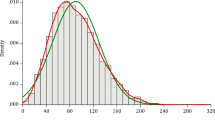Abstract
Networks of rain gauges can provide a better insight into the spatial and temporal variability of rainfall, but they tend to be too widely spaced for accurate estimates. A way to estimate the spatial variability of rainfall between gauge points is to interpolate between them. This paper evaluates the spatial autocorrelation of rainfall data in some locations in Peninsular Malaysia using geostatistical technique. The results give an insight on the spatial variability of rainfall in the area, as such, two rain gauges were selected for an in-depth study of the temporal dependence of the rainfall data-generating process. It could be shown that rainfall data are affected by nonlinear characteristics of the variance often referred to as variance clustering or volatility, where large changes tend to follow large changes and small changes tend to follow small changes. The autocorrelation structure of the residuals and the squared residuals derived from autoregressive integrated moving average (ARIMA) models were inspected, the residuals are uncorrelated but the squared residuals show autocorrelation, and the Ljung–Box test confirmed the results. A test based on the Lagrange multiplier principle was applied to the squared residuals from the ARIMA models. The results of this auxiliary test show a clear evidence to reject the null hypothesis of no autoregressive conditional heteroskedasticity (ARCH) effect. Hence, it indicates that generalized ARCH (GARCH) modeling is necessary. An ARIMA error model is proposed to capture the mean behavior and a GARCH model for modeling heteroskedasticity (variance behavior) of the residuals from the ARIMA model. Therefore, the composite ARIMA–GARCH model captures the dynamics of daily rainfall in the study area. On the other hand, seasonal ARIMA model became a suitable model for the monthly average rainfall series of the same locations treated.







Similar content being viewed by others
References
Appiah SK, Mueller U, Cross J (2011) Spatio-temporal modelling of malaria incidence for evaluation of public health policy interventions in Ghana, West Africa. 19th International Congress on Modelling and Simulation, Perth, Australia, 12–16 December 2011, http://mssanz.org.au/modsim2011
Bollerslev T (1986) Generalized autoregressive conditional heteroskedasticity. J Econometrics 31(3):307–327. doi:10.1016/0304-4076 (86)90063-1
Bollerslev T, Chou RY, Kroner KF (1992) ARCH modeling in finance. A review of the theory and empirical evidence. J Econometrics 52:5–59
Box GEP, Jenkins GM (1976) Time series analysis: forecasting and control. Holden-Day, Boca Raton
Buytaert W, Rolando C, Patrick W, De Bièvre B, Guido W (2006) Spatial and temporal rainfall variability in mountainous areas: a case study from the south Ecuadorian Andes. Journal of Hydrol 1:9. doi:10.1016/j.jhydrol.2006.02.031
Chang K-T (2012) Introduction to geographic information systems, Sixth edn. McGraw Hill, Singapore, pp 314–338
Engle RF (1982) Autoregressive conditional heteroscedasticity with estimates of variance of United Kingdom inflation. Econometrica 50:987–1008
Goovaerts P (2000) Geostatistical approaches for incorporation elevation into the spatial interpolation of rainfall. J. Hydrol. 228:113–129
Hanaish IS, Kamarulzaman I, Abdul Aziz J (2011) Stochastic modeling of rainfall in Peninsular Malaysia using Bartlett Lewis rectangular pulses models. Model Simulat Eng 2011(253735): 6 pages, doi:10.1155/2011/253735
Ho MK, Fadhilah Y (2012) Homogeneity tests on daily rainfall series in Peninsular Malaysia. Int. J. Contemp. Math. Sciences. 7(1):9–22
Hong Y (2006) Serial correlation and serial dependence. Wise working paper series, June 2006 The Wang Yanan Institute for studies in Economics, Xiamen University. http://www.wise.xmu.edu.cn/discourse/2006/HONG_Yongmiao_Serial_Correlation.pdf, WISEWP0601, 1–28
Johnston K, Ver Hoef MJ, Krivoruchko K, Lucas N (2001) Using ArcGIS geostatistical analyst. ESRI. p 306. http://direitosminerarios.com/pdf/ESRI
Jorge G, Lobo V, Ana CC (2012) Spatial characterization of extreme precipitation in Madeira Island using geostatistical procedures and a 3D SOM. The Fourth International Conference on Advanced Geographic Information Systems, Applications, and Services. IARIA, 2012, 1–6, ISBN: 978-1-61208-178-6
Juneng L (2010) Forecasting the Malaysian winter monsoon rainfall anomalies using statistical techniques. National Seminar on meteorology: School of Environment and Natural Resource Sciences, Faculty of Science and Technology Universiti Kebangsaan Malaysia
Laux P, Vogl S, Qiu W, Knoche HR, Kunstmann H (2011) Copula-based statistical refinement of precipitation in RCM simulations over complex terrain. Hydrol Earth Syst Sci Discuss 8:3001–3045. www.hydrol-earth-syst-sci-discuss.net/8/3001/2011/, doi:10.5194/hessd-8-3001-2011
Ljung GM, Box GEP (1978) On a measure of a lack of fit in time series models. Biometrika 65(2):297–303. doi:10.1093/biomet/65.2.297
Madsen H (2008) Time series analysis. Chapman & Hall, London
Suhaila J, AbdulAziz J (2007) Fitting the statistical distributions to the daily rainfall amount in peninsular Malaysia. Jurnal Teknologi Universiti Teknologi Malaysia 46(C):33–48
Suhaila J, Ching-Yee K, Fadhilah Y, Hui-Mean F (2011) Introducing the mixed distribution in fitting rainfall data. Open J Mod Hydrol 1(2):11–22. doi:10.4236/ojmh.2011.12002, http://www.SciRP.org/journal/ojmh
Svetlíková D, Kohnova S, Szolgay J, Komorníková M, Hlavčová K (2009) Analysis of monthly discharge and precipitation time series for selected wetlands in Slovakia. International Symposium on Water Management and Hydraulic Engineering, Ohrid/Macedonia, 1–5 September 2009, A91
Szolgayova E (2011) Modelling and forecasting daily river discharge considering autoregressive heteroskedasticity. Geophys Res Abstr 13, EGU2011-10681-1
Velasco-Forero C, Sempere-Torres D, Cassiraga EF, Gómez-Hernández J (2009) A non-parametric automatic blending methodology to estimate rainfall fields from rain gauge and radar data. Adv. Water Resour 32:986–1002
Villarini G, Smith JA, Napolitano F (2010) Nonstationary modeling of a long record of rainfall and temperature over Rome. Advances in Water Resources 33(10):1256–1267
Wang W, Van Gelder PHA, Vrijling JK, Ma J (2005) Testing and modelling autoregressive conditional heteroskedasticity of streamflow processes. Nonlin. Processes Geophys. 12:55–66. doi:10.5194/npg-12-55-2005
Wong CL, Venneker R, Uhlenbrook S, Jamil ABM, Zhou Y (2009) Variability of rainfall in Peninsular Malaysia. Hydrol Earth Syst Sci Discuss 6:5471–5503, www.hydrol-earth-syst-sci-discuss.net/6/5471/2009/
Yang T, Shao Q, Hao Z-C, Chen X, Zhang Z, Xu C-Y, Sun L (2010) Regional frequency analysis and spatio-temporal pattern characterization of rainfall extremes in the Pearl River Basin, China. J Hydrol 380:386–405. doi:10.1016/j.jhydrol.2009.11.013
Zalina MD, Amir HMK, Mohd NMD, Van-Thanh VN (2002) Statistical analysis of at-site extreme rainfall processes in Peninsular Malaysia. Proceedings of the Fourth International FRIEND Conference held at Cape Town. South Africa. March 2002. IAHS Publ. no. 274. 61-68
Author information
Authors and Affiliations
Corresponding author
Rights and permissions
About this article
Cite this article
Yusof, F., Kane, I.L. Volatility modeling of rainfall time series. Theor Appl Climatol 113, 247–258 (2013). https://doi.org/10.1007/s00704-012-0778-8
Received:
Accepted:
Published:
Issue Date:
DOI: https://doi.org/10.1007/s00704-012-0778-8




